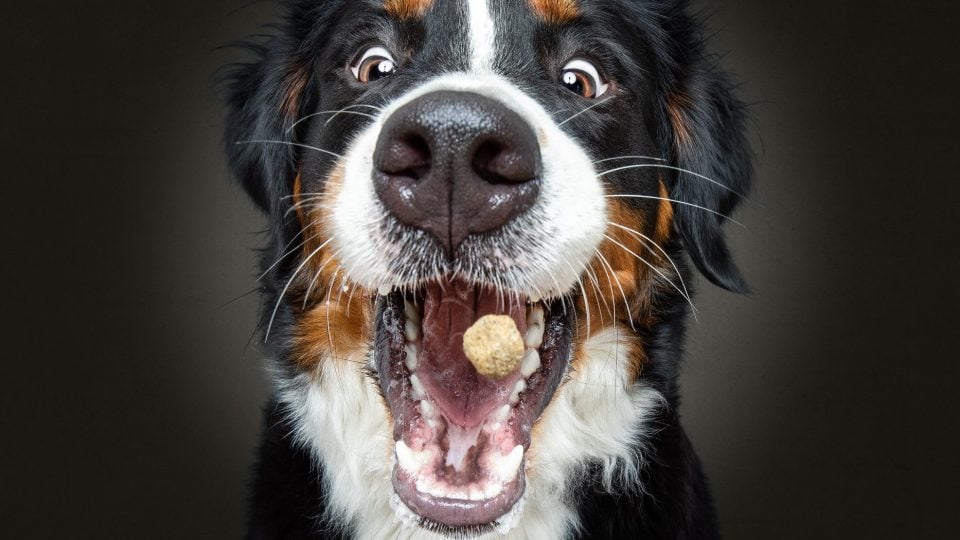A few weeks go, both of my dogs refused their morning meal. They’re not picky eaters—AT ALL—so I knew something strange was going on. On closer inspection, I realised their dry food smelled a little funky. The remains of a bag had gone rancid.
Worried about your dog’s food spoiling? Read on to learn what causes dog food to spoil, how to tell if your dog’s food has gone bad, and how to store dog food correctly to prevent spoilage.
What causes dog food to spoil
The most common causes of food spoilage are:
- Exposure to air, which feeds harmful bacteria
- Excess moisture in the environment, which causes to mould
- High temperatures, which lead to rancidity
In general, it’s best to store dry dog food in a cool, dry place. A climate-controlled environment is best, i.e. the kitchen pantry or a cupboard indoors. Keeping dog food away from temperature fluctuations and moisture will keep it fresh!
How to tell if your dog food is spoiled
Dogs have incredible senses of smell, and will pick up odours we humans can’t find. If your pet sniffs the bowl and turns their head, or takes a few bites before walking away, there might be something wrong with their food. Your dog’s nose knows!
Of course, some dogs will eat anything. That’s why it’s important for you to know the signs of food that has “gone off.” You can tell your dog food is spoiled if:
- There is a noticeable sour or rancid odour
- You see signs of moisture, mould, or bugs
- The bag is past its expiration date
- The food has been exposed to heat or humidity
- Your dog refuses to eat, or shows signs of illness/discomfort after eating
Now that you know how to identify spoiled food, read on to learn how to keep dog food fresh.
Keep it in the bag (or tin)
https://www.instagram.com/p/_sDz3dsr6b/?tagged=dogfoodbag
Dog food bags are designed specifically to keep dry dog food fresh. While food storage containers are useful for disguising bags (and keeping them safe from clever scavenger dogs), they’re actually not the best option on their own.
Now, this doesn’t mean you can’t use a food storage container! We love pet food storage solutions, we just recommend storing the bag inside the container. It can take some strategic bag-wrangling to get it to fit, but it will be worth it to keep your dog’s food safe.
If your dog eats canned food, store any leftovers in the original can with an air-tight lid. Canned food will stay good for 3-5 days when stored properly in the fridge.
If you do use a food storage container, be sure to clean it regularly. Every time you finish a bag of dog food, wash the container out, and let it dry completely before putting a new bag in.
Keep it sealed and cool
https://www.instagram.com/p/nQwSSaED6k/?tagged=dogfoodstorage
Exposure to air and humidity can speed up the rate at which dog foods degrade. As fats and proteins break down in air/moisture, they become rancid, and are at risk for bacterial contamination.
You can prevent spoilage by sealing the dog food bag up tight. Use a combination of a bag clip and air-tight storage container.
In addition, dry food should be stored in a cool, dry environment. At high temperatures, the fat in food starts to oxidise, causing rancidity. Keep your dog’s food in a climate-controlled spot where the temperature is consistently under 38°C (100°F).
Pay attention to expiration dates
Manufacturers establish “best by” dates to ensure the safety of your dog. Look for the expiration date on the bottom of your dog’s food bag or cans, and plan to use up the food before that date.
In general, unopened dry pet foods have a shelf life of one year, while unopened canned foods are good for two years from the date of manufacture. Dry food, when stored properly, should last through the manufacturer’s indicated expiration date.
More dog food articles
Here at Rover we offer a collection of articles on foods that are safe or toxic and dangerous for dogs to eat. We’ve created these articles to ensure you’re informed on feeding your dog a wonderfully varied diet while learning the limitations of a dog’s sensitive digestive system. You might also be interested in:
- What to Do When Your Dog is a Picky Eater
- More UK Dogs Are Being Fed Alternative Diets According to Our New Survey
- The Top 7 Most Common Food Allergens for Dogs
- Grain-Free Dog Food: Is It Always Better, and Which Brands Are Best?



